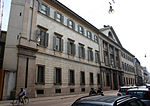Casa Fontana-Silvestri
Palaces in MilanProvince of Milan geography stubsRenaissance architecture in Milan

Casa Fontana-Silvestri is one of the few Renaissance buildings surviving in Milan, Italy. The main structure dates back to the 12th century, but its current form is due to a thorough modification that were made at the end of the 14th century, in a style that mixes Renaissance and Gothic elements. The facade was originally decorated with frescos that scholars credit to Bramante or Bramantino; most of these painting have disappeared, with just a few remnants now visible under the cornice. It has also been suggested that Bramante may have designed the cotto decorations, also on the facade.
Excerpt from the Wikipedia article Casa Fontana-Silvestri (License: CC BY-SA 3.0, Authors, Images).Casa Fontana-Silvestri
Corso Venezia, Milan Municipio 1
Geographical coordinates (GPS) Address External links Nearby Places Show on map
Geographical coordinates (GPS)
| Latitude | Longitude |
|---|---|
| N 45.468188888889 ° | E 9.1988611111111 ° |
Address
Casa Fontana Silvestri
Corso Venezia
20121 Milan, Municipio 1
Lombardy, Italy
Open on Google Maps










